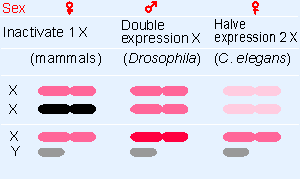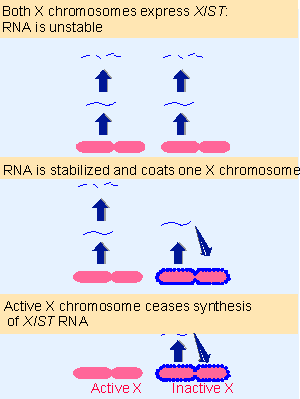14. Global changes in X chromosomes
19.14 Global changes in X chromosomes |
| Key terms defined in this section |
| Constitutive heterochromatin describes the inert state of permanently nonexpressed sequences, usually satellite DNA. Dosage compensation describes mechanisms employed to compensate for the discrepancy between the presence of two X chromosomes in one sex but only one X chromosome in the other sex. Facultative heterochromatin describes the inert state of sequences that also exist in active copies-for example, one mammalian X chromosome in females. Single X hypothesis describes the inactivation of one X chromosome in female mammals. |
 |
Figure 19.47 Different means of dosage compensation are used to equalize X chromosome expression in male and female. |
Sex presents an interesting problem for gene regulation, because of the variation in the number of X chromosomes. If X-linked genes were expressed equally well in each sex, females would have twice as much of each product as males. The importance of avoiding this situation is shown by the existence of dosage compensation, which equalizes the level of expression of X-linked genes in the two sexes. Mechanisms used in different species are summarized in Figure 19.47:
- In mammals, one of the two female X chromosomes is inactivated completely. The result is that females have only one active X chromosome, which is the same situation found in males. The active X chromosome of females and the single X chromosome of males are expressed at the same level.
- In Drosophila, the expression of the single male X chromosome is doubled relative to the expression of each female X chromosome.
- In C. elegans, the expression of each female X chromosome is halved relative to the expression of the single male X chromosome.
The common feature in all these mechanisms of dosage compensation is that the entire chromosome is the target for regulation. A global change occurs that quantitatively affects all of the promoters on the chromosome. We know most about the inactivation of the X chromosome in mammalian females, where the entire chromosome becomes heterochromatin.
The twin properties of heterochromatin are its condensed state and associated inactivity. It can be divided into two types:
- Constitutive heterochromatin contains specific sequences that have no coding function. Typically these include satellite DNAs, and are often found at the centromeres. These regions are invariably heterochromatic because of their intrinsic nature.
- Facultative heterochromatin takes the form of entire chromosomes that are inactive in one cell lineage, although they can be expressed in other lineages. The example par excellence is the mammalian X chromosome. The inactive X chromosome is perpetuated in a heterochromatic state, while the active X chromosome is part of the euchromatin. So identical DNA sequences are involved in both states. Once the inactive state has been established, it is inherited by descendant cells. This is an example of epigenetic inheritance, because it does not depend on the DNA sequence,
 |
Figure 19.48 X-linked variegation is caused by the random inactivation of one X chromosome in each precursor cell. Cells in which the + allele is on the active chromosome have wild phenotype; but cells in which the - allele is on the active chromosome have mutant phenotype. |
Our basic view of the situation of the female mammalian X chromosomes was formed by the single X hypothesis in 1961. Female mice that are heterozygous for X-linked coat color mutations have a variegated phenotype in which some areas of the coat are wild-type, but others are mutant. Figure 19.48 shows that this can be explained if one of the two X chromosomes is inactivated at random in each cell of a small precursor population. Cells in which the X chromosome carrying the wild-type gene is inactivated give rise to progeny that express only the mutant allele on the active chromosome. Cells derived from a precursor where the other chromosome was inactivated have an active wild-type gene. In the case of coat color, cells descended from a particular precursor stay together and thus form a patch of the same color, creating the pattern of visible variegation. In other cases, individual cells in a population will express one or the other of X-linked alleles; for example, in heterozygotes for the X-linked locus G6PD, any particular red blood cell will express only one of the two allelic forms. (Random inactivation of one X chromosome occurs in eutherian mammals. In marsupials, the choice is directed: it is always the X chromosome inherited from the father that is inactivated. (Lyon, 1961))
Inactivation of the X chromosome in females is governed by the n V1 rule: however many X chromosomes are present, all but one will be inactivated. In normal females there are of course 2 X chromosomes, but in rare cases where nondisjunction has generated a 3X or greater genotype, only one X chromosome remains active. This suggests a general model in which a specific event is limited to one X chromosome and protects it from an inactivation mechanism that applies to all the others.
A single locus on the X chromosome is sufficient for inactivation. When a translocation occurs between the X chromosome and an autosome, this locus is present on only one of the reciprocal products, and only that product can be inactivated. By comparing different translocations, it is possible to map this locus, which is called the Xic (X-inactivation center). A cloned region of 450 kb contains all the properties of the Xic. When this sequence is inserted as a transgene on to an autosome, the autosome becomes subject to inactivation (in a cell culture system) (Lee et al., 1996).
Xic is a cis-acting locus that contains the information necessary to count X chromosomes and inactivate all copies but one. Inactivation spreads from Xic along the entire X chromosome. When Xic is present on an X chromosome-autosome translocation, inactivation spreads into the autosomal regions (although the effect is not always complete).
Xic contains a gene, called Xist, that is expressed only on the inactive X chromosome. The behavior of this gene is effectively the opposite from all other loci on the chromosome, which are turned off. Deletion of Xist prevents an X chromosome from being inactivated. However, it does not interfere with the counting mechanism (because other X chromosomes can be inactivated). So we can distinguish two features of Xic: an unidentified element(s) required for counting; and the Xist gene required for inactivation.
 |
Figure 19.49 X-inactivation involves stabilization of XIST RNA, which coats the inactive chromosome. |
Figure 19.49 illustrates the role of Xist RNA in X-inactivation. Xist codes for an RNA that lacks open reading frames. The Xist RNA "coats" the X chromosome from which it is synthesized, suggesting that it has a structural role. Prior to X-inactivation, it is synthesized by both female X chromosomes. Following inactivation, the RNA is found only on the inactive X chromosome. The transcription rate remains the same before and after inactivation, so the transition depends on post-transcriptional events (Penny et al., 1996).
Prior to X-inactivation, Xist RNA decays with a half life of ~2 hrs. X-inactivation is mediated by stabilizing the Xist RNA on the inactive X chromosome. The Xist RNA shows a punctate distribution along the X chromosome, suggesting that association with proteins to form particulate structures may be the means of stabilization. We do not know yet what other factors may be involved in this reaction and how the Xist RNA is limited to spreading in cis along the chromosome. The characteristic features of the inactive X chromosome, which include a lack of acetylation of histone H4, and methylation of CpG sequences (see below), presumably occur later as part of the mechanism of inactivation (Panning and Dausman, 1997; Jeppesen and Turner, 1993).
The n V1 rule suggests that stabilization of Xist RNA is the "default," and that some blocking mechanism prevents stabilization at one X chromosome (which will be the active X). This means that, although Xic is necessary and sufficient for a chromosome to be inactivated, the products of other loci may be necessary for the establishment of an active X chromosome.
Silencing of Xist expression is necessary for the active X. Deletion of the gene for DNA methyltransferase prevents silencing of Xist, probably because methylation at the Xist promoter is necessary for cessation of transcription (the effects of methylation on transcription are discussed in 21 Regulation of transcription).
Global changes occur in other types of dosage compensation. In Drosophila, a complex of proteins is found in males, where it localizes on the X chromosome. In C. elegans, a protein complex associates with both X chromosomes in XX embryos, but the protein components remain diffusely distributed in the nuclei of XO embryos. The protein complex contains an SMC core, and is similar to the condensin complexes that are associated with mitotic chromosomes in other species. This suggests that it has a structural role in causing the chromosome to take up a more condensed, inactive state. Multiple sites on the X chromosome may be needed for the complex to be fully distributed along it.
Changes affecting all the genes on a chromosome, either negatively (mammals and C. elegans) or positively (Drosophila) are therefore a common feature of dosage compensation. However, the components of the dosage compensation apparatus may vary as well as the means by which it is localized to the chromosome, and of course its mechanism of action is different in each case.
| Research | |
| Jeppesen, P. and Turner, B. M. (1993). The inactive X chromosome in female mammals is distinguished by a lack of histone H4 acetylation, a cytogenetic marker for gene expression. Cell 74, 281-289. | |
| Lee, J. T. et al. (1996). A 450 kb transgene displays properties of the mammalian X-inactivation center. Cell 86, 83-94. | |
| Lyon, M. F. (1961). Gene action in the X chromosome of the mouse. Nature 190, 372-373. | |
| Panning, B., Dausman, J., and Jaenisch, R. (1997). X chromosome inactivation is mediated by Xist RNA stabilization. Cell 90, 907-916. | |
| Penny, G. D. et al. (1996). Requirement for Xist in X chromosome inactivation. Nature 379, 131-137. | |